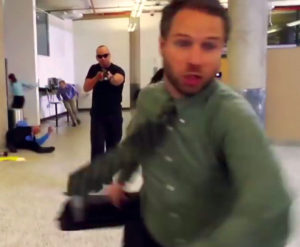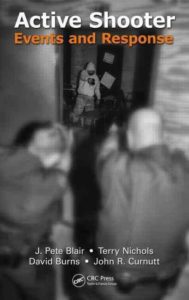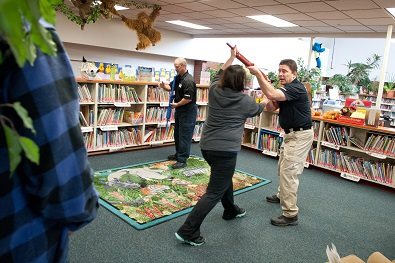This is the interview I did with Derrell Day on Talk Radio 101.1 FM yesterday (6-6-17) regarding active shooters and the workplace shooting that happened in Orlando.
Check out more interviews on the Media page.
This is the interview I did with Derrell Day on Talk Radio 101.1 FM yesterday (6-6-17) regarding active shooters and the workplace shooting that happened in Orlando.
Check out more interviews on the Media page.
 Government statistics show that fatal workplace shootings, like happened in Orland today, are on the rise.
Government statistics show that fatal workplace shootings, like happened in Orland today, are on the rise.
In a report by Laurie Kellman, associated press, Kellman states:
“Revenge against an employer, romantic partner or co-workers often is the motive, experts say. Reports of workplace violence are quick to spread across social media. ‘It really all boils down pretty much to the same issues: A person wants to feel that they have more control, they want to have more power,’ said threat assessment expert Michael Corcoran. ‘What are seeing when this happens is it gets played up more, so they say, ‘Ah OK, that’s an alternative.” What has changed in recent years is the willingness of employers to set up systems to monitor people who might be threats, experts said.”
One of the things I discuss in my Survive a Shooting course is a threat assessment team, and how organizations can set up systems to monitor people that might be a threat. This is an important “before” step. Ideally, we prevent these workplace shootings rather than react to them.
Kellman also reported:
“Identifying people with ‘concerning behavior’ is key for virtually any company, experts said. That means setting up an ‘interdisciplinary threat assessment team’ of company managers and, sometimes, local law enforcement, to look at and perhaps track workers who were terminated or suspended, said Matthew W. Doherty, senior vice president for threat and violence risk management at Hillard Heintze.”
Times are changing, and sadly, some not for the better. I do not know why there is an increase in workplace shootings, but I do know that hiding under a desk and hoping is not a plan for survival. There are things that can be done before, during, and after and incident to decrease the body count these sick individuals are after. This site, and the Survive a Shooting course, are designed to help you do just that.
Active Shooter Response training video that was recorded live on Facebook last Friday. It was a good session with questions regarding Active Shooter Response training and other active threats. The training isn’t just for Active Shooters. The training, as you can see if you check out the page on the course covers how to respond to other threats, including knives, too.
I’m not sure why the video and audio are off a bit when I put Facebook Live videos on YouTube. Just pretend it’s an old Kung Fu Theater movie. It’s the information you want to hear anyway. So enjoy it, learn, and stay safe.
 Suicide Bombers? But this site is about Active Shooters, right? The site, and the Survive a Shooting course, are about surviving active threats, and that includes bombings too. The signs to look for with suicide bombers are also signs for some active shooters.
Suicide Bombers? But this site is about Active Shooters, right? The site, and the Survive a Shooting course, are about surviving active threats, and that includes bombings too. The signs to look for with suicide bombers are also signs for some active shooters.
The problem is, the best strategy for surviving a bomb is to be somewhere else when it goes off. You must be outside the kill zone. That’s easier said than done, I know. So, what can you do?
Be aware (like you haven’t heard me say that before), especially when out at an event with a lot of people gathered together. (stadiums, event centers, etc.)
Signs to Look For With Suicide Bombers:
The smart suicide bomber will probably explode before anyone knows what is going on. However, not all terrorists are smart. Here are some things to look for:
Once a bomb is detonated, the damage is done. If you are unfortunate enough to be in the kill zone, it doesn’t matter, you will be killed or injured. However, if you’re at an event and a bomb does explode, and you are not severely injured, the first thing to remember is to remain calm. Sure you say, and I know that saying that is much easier than doing it. But remember, you won’t help anyone by panicking. Training, visualization, etc. can help you prepare so you don’t panic during an emergency. Also remember to breathe. Combat breathing as I teach in my classes and write about will help you keep your wits about you in the middle of chaos.
Look for cover. Something or someplace that offers protection. There could be additional explosions. Avoid things that could fall on you. Prepare to evacuate (you’ve heard me preach about knowing all of the available exits before), but don’t evacuate immediately. Terrorists have been known to place additional bombs in evacuation paths. They have also been known to place them at evacuation points. (Such as placing a car bomb in the parking lot that all the people inside an event center or stadium will evacuate to.) Obviously, if there is fire or something else that requires you to evacuate immediately, do so. Just be alert for additional threats and dangers.
If emergency personnel are on the scene, follow instructions. Don’t move injured people unless you must to prevent further injury or to move them from further threats. Remember, there could still be bad guys in the area. Move with purpose but caution.
Terrorists are real threats in the world we live in. It’s only prudent to be prepared. Stay aware, have a plan, and enjoy life safely.
 Active Shooter Tip – Be aware!
Active Shooter Tip – Be aware!
We must keep our heads out of our apps and be aware of what is going on around us. Know what is “normal” for the area and situation to recognize behaviors that aren’t normal. Too many of us go through the day oblivious of our surroundings until something happens – the warning signs are out there if you’re paying attention.
You won’t be able to Escape, Deny, or Attack Back if you aren’t first aware of the threat in the first place. So be aware. It will help you in an emergency, and it allows you to see the good things too.
(The picture used on this blog has the sister site logo, Survive and Defend, because I used to put Active Shooter Response tips and information there before this site was up and running.)
Do you know what you would do if someone burst into your place of employment and started shooting people? Where would you go if you heard shots being fired down the hall? Do you know how to effectively lock down and barricade? How can you attack back and survive?
You don’t have to have an elaborate plan, in fact simple is best, but you MUST have a plan. You don’t want to be caught not knowing what to do. When seconds count, help is only minutes away, and you must know what to do to immediately save your life and keep you safe.
Book a live class, or have your employer bring me in to teach you as soon as possible!
Shooting in California and Knife Attack in Texas is a video filmed live on Facebook discussing, what else, a Shooting in California and a Knife Attack in Texas. The sound and picture are off, and not sure why that happened when transferring from Facebook. So just listen to the information or pretend you are watching one of the old Kung Fu movies dubbed in English.
These kinds of attacks do happen, so stay aware, have a plan, and Stay safe!
 Do you need to be a martial arts expert or have special forces training to survive an attack by a gun or knife?
Do you need to be a martial arts expert or have special forces training to survive an attack by a gun or knife?
No. You need to be able to get past denial and assess the situation. You need a plan. You need to have walked through it and have had some basic training. You need to know if you can escape, deny, or attack back. You need to Move and do one of these three options immediately with commitment.
I teach all kinds of people how to survive. Sure, I also teach martial art classes and help people achieve their black belts in the Korean self-defense art of Hapkido, but that is not required to be a survivor. The strategies and tactics in the Survive a Shooting course focus on simple things than anyone can learn and implement.
You can survive!
 Active Shooter: Events and Response is written by members of the Advanced Law Enforcement Rapid Response Training (ALERRT) Center at Texas State University: J. Pete Blair, Terry Nichols, David Burns, and John R. Curnutt. I am familiar with this group because a few of the law enforcement officers of our training group know these authors, and in the Acknowledgments, Marcus “Sandy” Wall is thanked for helping introduce the training methodology and curriculum that became the ALERRT program. I mention this because Sandy Wall was one of the instructors who taught the Safariland Trainer Course “Emergency Response to an Armed Intruder” that I attended.
Active Shooter: Events and Response is written by members of the Advanced Law Enforcement Rapid Response Training (ALERRT) Center at Texas State University: J. Pete Blair, Terry Nichols, David Burns, and John R. Curnutt. I am familiar with this group because a few of the law enforcement officers of our training group know these authors, and in the Acknowledgments, Marcus “Sandy” Wall is thanked for helping introduce the training methodology and curriculum that became the ALERRT program. I mention this because Sandy Wall was one of the instructors who taught the Safariland Trainer Course “Emergency Response to an Armed Intruder” that I attended.
Since I’ve been studying active shooter events, and teaching courses on responses to active shooters, I started reading this book with more knowledge than many readers. I found the book to be well organized, on-point, and a great resource for my own writing and teaching on the subject. I will point out that the courses I teach are for civilians, many teachers and school employees, and this book has a large portion on law enforcement response and tactics. However, there are chapters on civilian responses to active shooters that mirrors the classes we teach.
Here is what this book covers chapter by chapter:
The book then concludes with an Appendix that contains brief summaries of all of the Active Shooter Events from 2000 to 2010. These are the events that are included in the chapter with the break down and analysis.
I found Active Shooter: Events and Response to be a very good book on the topic. It is a very good reference for my writing and teaching, and I feel it would be a good read for all law enforcement as well as civilians wanting to know more about what both law enforcement is doing in response to these events and what they can do if ever faced with such an unthinkable situation.
Knowledge is power, and this book provides knowledge on the history of active shooter events and what can be done to address this increasing threat. I wish a book like this wasn’t necessary, but in the times we live in, I’m glad this book is available to provide the information to those of us in the good fight. Train and prepare before one of these situations occurs in your hometown, and may you never need your training. Stay safe.
Active Shooter: Events and Response at amazon:
 Survive the shooting! That is your goal if the unthinkable breaks out. You must SURVIVE!
Survive the shooting! That is your goal if the unthinkable breaks out. You must SURVIVE!
These ten tip introduce some of the strategies and tactics taught at Survive A Shooting, and in the Survive a Shooting classes.
Think of these as an introduction, and quick reminders as what you need to do to survive an active shooter or active threat incident.